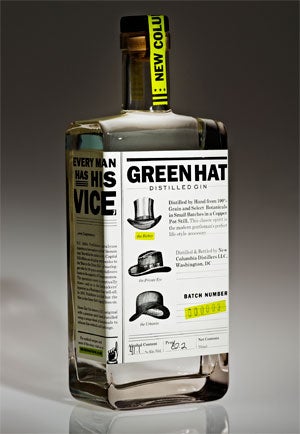When retired lawyer Michael Lowe and son-in-law John Uselton launched New Columbia Distillers, the first distillery in the nation's capital since Prohibition, they were thirsting for a website and brand that would capitalize on the story of their inaugural brew, Green Hat Gin.
Paying homage to D.C.'s spirited past, the name nods to infamous bootlegger George Cassiday, whose trademark was a green fedora.
As the startup's primary marketing tool, the website needed to engage the company's hip, web-savvy target demographic and feel as custom and unique as the craft distillery's limited-distribution spirits. Lowe and Uselton turned to renowned D.C. creative firm Design Army, whose clients range from The Washington Ballet to Bloomingdale's. The 11-person shop, led by husband-and-wife graphic designers Jake and Pum Lefebure, designed Green Hat's logo, with its cleverly integrated hat motif, and conceived a website that feels as if the user is flipping through old-style newspapers and catalogs from the 1920s.
"We didn't want to create just a click, click, click site," Jake Lefebure says. "We wanted something more fluid and smooth, in the same way you would read a newspaper and flip the pages as you scroll. We also knew a lot of users would be on mobile and tablets, so making it natural to navigate on those devices was the way to go."

Green Hat Gin
Image credit: Green Hat Gin
The design not only stays true to Green Hat Gin's storied history, it also creates a brand that is visually distinct from its competitors. Incorporating old-fashioned catalog illustrations, fonts reminiscent of newspaper headlines and text, and cocktails playfully distinguished by hat styles, the product achieves a visual voice all its own.
"The website is quite distinctive but also structured so we could provide all the practical information to make it useful to our customers and establish our brand," Lowe says. "It's old-style on the surface but very much updated in its use. It really makes it an experience for somebody visiting the site."
The website took about three weeks for creative and six weeks for customizing WordPress CMS templates. "The back end was a simple build with fairly basic programming, but you would never guess that as a typical end-user," Jake Lefebure says.
From the shelf to the website, the design sensibilities are consistent. "Because it's a new product, having the bottle label and site match perfectly was critical to create brand recognition so consumers start to remember the product," Pum Lefebure says. "Design is no longer just cosmetic or 'make something pretty.' Good designers think strategically, ask the right questions and help their clients' businesses grow."
It seems the effort is paying off. "For a brand-new product like ours, garnering the kind of interest we've had in our website has been crucial," Lowe says. "Not only has it helped get the word out, we've had so many people come to the distillery and comment, 'Your website is spectacular. It really made me want to visit you.'"
Web Design Basics
Appearance is everything.
"Don't just think of a website as a website; think of it as your storefront," says Design Army co-founder Pum Lefebure. "If it looks cheap, you will appear cheap. If it looks expensive, then you can sell your product at a higher price point."
"Don't just think of a website as a website; think of it as your storefront," says Design Army co-founder Pum Lefebure. "If it looks cheap, you will appear cheap. If it looks expensive, then you can sell your product at a higher price point."
Go where your customers go.
"You have to design for mobile," Lefebure says. "Everyone has a smartphone or tablet, so it's crucial your customers can access all your information at all times." Equally important, she says, "you need to integrate social media into your website, because that's where everyone is communicating today."
"You have to design for mobile," Lefebure says. "Everyone has a smartphone or tablet, so it's crucial your customers can access all your information at all times." Equally important, she says, "you need to integrate social media into your website, because that's where everyone is communicating today."
Think ahead.
"Design a website with room to grow, where you have the ability to add more sections," she explains. "You never know what your next business venture may be six months from now, and you don't [want] to redesign the site again."
"Design a website with room to grow, where you have the ability to add more sections," she explains. "You never know what your next business venture may be six months from now, and you don't [want] to redesign the site again."
Don't cut corners.
"Don't assume your project is too small for a larger design agency," says Design Army co-founder Jake Lefebure. "If you're strapped for cash, be upfront with the agency. We often set up payment plans or look to invest in projects where our clients can't afford everything at once."
"Don't assume your project is too small for a larger design agency," says Design Army co-founder Jake Lefebure. "If you're strapped for cash, be upfront with the agency. We often set up payment plans or look to invest in projects where our clients can't afford everything at once."
Article written by: Stephanie Orma. Originally posted: http://www.entrepreneur.com/article/227921#ixzz2jiIPWLWc
